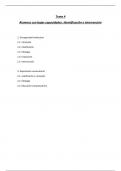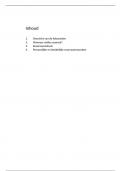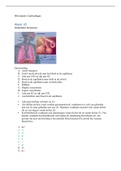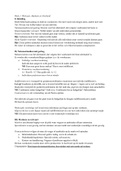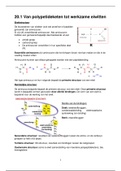CHAPTER 1: INTRODUCTION
- EU law = a source of law (not a branch of law)
- EU law = national law
o EU law has always primacy over national law. So national law has to enforce EU law as if it is national
law.
- EU constitutional law ↔ EU substantive law
o EU constitutional law (grondwettelijk recht): How the EU works; what is the content of the ‘constitution’ of
the EU…
o EU substantive law: EU law covering the different branches of law (s.e. EU social law…)
- EEC → EC → EU
o EEC = European Economic Community
o EC = European Community
o EU = European Union
- Up-to-date copy of the TEU, the TFEU and the CFREU
o TEU = Treaty of the EU (= Verdrag betreffende de Europese Unie, VEU)
o TFEU = Treaty of the Function of the EU (= Verdrag over het functioneren van de Europese Unie, VWEU)
o CFREU = Charter of Fundamental Rights of the EU (= Handvest van fundamentele rechten van de
Europese Unie, HFREU)
Because of the Brexit, we now have 27 members of the EU. Until the end of 2020 they follow the rules of the EU, after
that, we still don’t know if there will be a soft Brexit or a hard Brexit.
1
,CHAPTER 2: THE CREATION OF A EUROPEAN UNION
2.1 THE EUROPEAN COMMUNITIES; WHY THEY WERE CREATED AND WHAT DO THEY
COMPRISE?
2.1.1 THE FIRST TREATIES
Students should understand:
- how and why the European Communities were established;
- what their aims and objectives are;
- how the institutions of the 3 European Communities merged into single institutions.
“A day will come when all the nations of this continent, without losing their distinct qualities or their glorious
individuality, will fuse together in a higher unity and form of European brotherhood.
A day will come when the only battlefield will be the marketplace for competing ideas.
A day will come when bullets and bombs will be replaced by votes.” – Victor Hugo, 1894
- Konrad Adenauer: first Chancellor of the Federal Republic
of Germany (West Germany) from 1949 to 1963
- Simone Veil: Holocaust survivor, French magistrate and
stateswoman who served as Health Minister in several
governments and was President of the European
Parliament from 1979 to 1982
- Winston Churchill: Prime Minister of the United Kingdom
from 1940 to 1945 during the Second World War, and
again from 1951 to 1955
- Alcide De Gasperi: Christian Democratic Prime Minister of
Italy in eight successive coalition governments from 1945
to 1953
- Robert Schuman: French Foreign Minister
- Jean Monnet: a senior French civil servant
Churchill’s “iron From Stettin in the Baltic to Trieste in the Adriatic an "Iron Curtain" has descended across the
Curtain” Speech continent.
(1946) Behind that line lie all the capitals of the ancient states of Central and Eastern Europe.
Warsaw, Berlin, Prague, Vienna, Budapest, Belgrade, Bucharest and Sofia; all these famous
cities and the populations around them lie in what I must call the Soviet sphere, and all are
subject, in one form or another, not only to Soviet influence but to a very high and in some
cases increasing measure of control from Moscow.
Fulton speech Winston Churchill warned of the rise of Soviet power and the descent of an ‘iron curtain’ across
(March 1946) the continent
Zurich speech he reiterated his call for a United States of Europe, based now on Franco-German
(19/9/1946) reconciliation, and proposed the creation of a Council of Europe as a stepping stone towards
that goal
2.1.1.1 EARLY FORMS OF COOPERATION
- 1948: organisation for European Economic Cooperation: to oversee Marshall Plan (since 1961 OECD, now 34
MS)
- 1949: North Atlantic Treaty Organisation (NATO, now 29 MS)
- 1949: Council of Europa (now 47 MS)
o European Convention on Human Rights (ECHR)
o European Court of Human Rights (ECtHR)
2
, 2.1.1.2 THE FIRST TREATIES
USA + UK
Treaty of Paris 1951 Treaties of Rome 1957
Second World War European Coal and Steel Community - European Economic Community
- European Atomic Energy Community
Relaunch
Failure of
Schuman Declaration 1950
Franco- German conciliation European Defence Community
Messina (René Pleven)
Conference 1955
Paul-Henri Spaak
East-West confrontation
- The first European community was the European Coal and Steel Community (ECSC)
- It was a plan based on economic co-operation in Europe and was proposed by Jean Monnet.
- Robert Schuman took it up.
- The plan allowed the two industries to be closely monitored.
- An invitation to participate was send to other European countries and the ECSC was finally created by the signing
of the Treaty of Paris 1951
→ six members: France, Germany, Italy, Belgium, Luxembourg, Netherlands
- 1945: the end of the Second World War have led to the creation of the European Union. The economies of the
European States had been devastated by successive wars & the people of Europe were anxious to build a
peaceful & stable future for themselves.
- They were supported by the USA, who saw co-operation between the Western European countries & Eastern
Europe.
- Churchill 1946: Iron Curtain Speech, he warned of the rise of the Soviet power (= Soviet sphere) & the descent
of an ‘iron curtain’ across the continent.
- 1948: the organization for Economic Co-operation was set up → to oversee Marshall Plan (since 1961 OECD),
now 34 MS.
- 1949: NATO = North Atlantic Treaty Organisation, 29 member states. The aims = related to defence.
- 1949: Council of Europe, now 47 MS
2.1.1.3 SCHUMAN DECLARATION 9 MAY 1950
The method “Jean Monnet” is also called neo-
Europe will not be functionalism.
built in a day nor Supplementing the technical logic of functional
as part of some Pooling of
overall design; it French and European spillover, neo-functionalists added the idea of
will be built German Coal and political spillover.
through practical coal and Steel This involved the build-up of political pressures
achievements that steel Community by interest groups, trade unions, and other actor
first create a production to encourage further integration, with the
sense of common
purpose. Commission acting as a catalyst for these
pressures.
2.1.1.4 EUROPEAN COMMUNITIES
European Coal and Steel European Economic Community European Atomic Energy
Community 1957 Community
1951 1957
- 6 countries - 6 countries - 6 countries
- For 50 years - For unlimited period - For unlimited period
- Common market in coal - Common market - Speedy establishment and
and steel o Free movement of goods, growth of nuclear sector
persons, services and capital
o Common policies
3
, European Atomic energy community still exists.
The European Atomic Energy Community (EURATOM) was signed in Rome 1957 by the same six countries which
made up the ECSC. The object: The furtherance of atomic energy for peaceful purposes, together with a commitment
to ensure uniform safety standards.
The European economic community (EEC) was born like EURATOM as a result of the Spaak Report and the treaty
establishing the EEC. This treaty was signed in Rome by the same six states as the treaties before. Further
similarities are that the new Community was to be administered by four bodies/institutions to which he Member States
had delegated (volmachtigd) the right of independent action in certain specified areas.
There was a difference between the EURATOM and ECSC and the EEC. The first 2 were limited in their scope, being
functionalist and their aims: the creation of a common market in coal and steel and in atomic energy. The EEC was
significantly broader in its approach. It was created with the task of working towards integration of all aspects of the
economies of its states, not only the integration of specific industries.
2.1.1.5 INSTITUTIONS
ECSC
High Autority
Council of Ministers
Parliamentary Convention on
Assembly certain institutions Merger Treaty 1965
Court of Justice common to the Single Commission
European
Single Council
Communities 1957
Single budget
EEC and EURATOM Parliamentary
Commision Assembly
Council of Ministers Court of Justice
Parliament
Court of Justice
2.2 THE DEVELOPMENT OF THE EUROPEAN ECONOMIC COMMUNITY (EEC)
Students should understand
- how both deepening and enlargement furthered European integration
- when the transitional period of the common market ended
- what the Luxembourg compromise is
- how the role of the EP steadily grew
- which important European summits influenced European integration
- how the Single European Act amended the founding Treaties
2.2.1 HISTORICAL DEVELOPMENT
Enlargement
Deepening 1973: United Kingdom,
Community Integration Denmark, Ireland
Path (Supranationalism) 1981: Greece
Non-Community 1986: Portugal and
Integration Path Spain (EEC12)
(Intergovernmentalism)
→ ’50
UK
didn’t wanted to be a member
→ Enlargement to the south: 12 countries are member
→ In the beginning it was ok but when the enlargement to eastern C the EU couldn’t take the pressure, so Macron
said they have to first deepen the EU and then enlarge.
4







